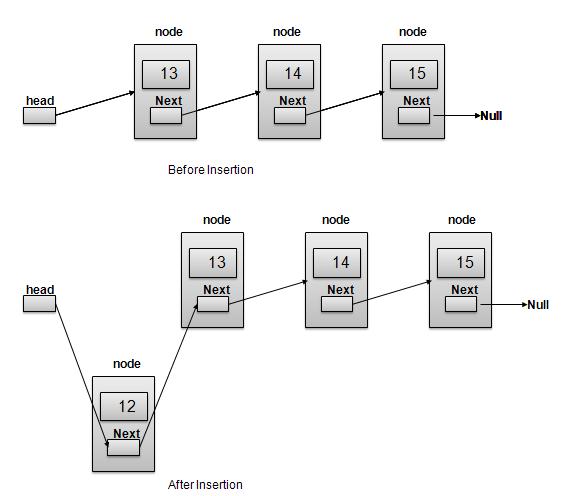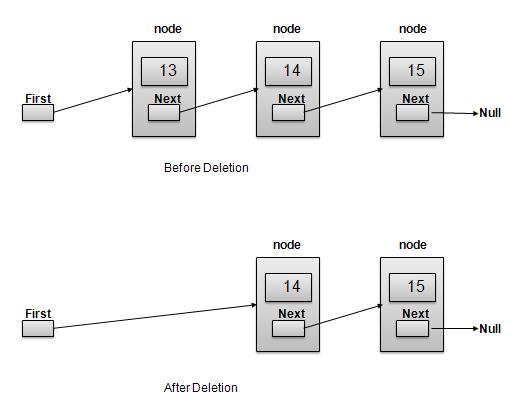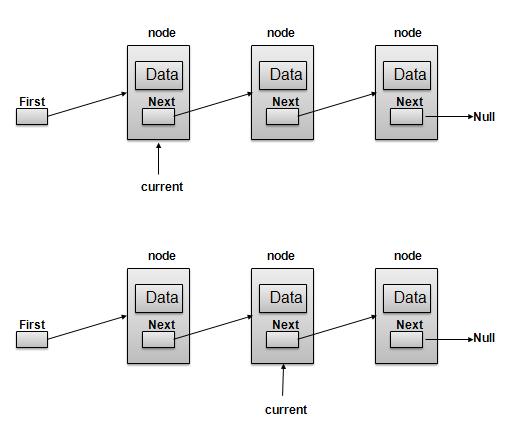
- DSA using C - Home
- DSA using C - Overview
- DSA using C - Environment
- DSA using C - Algorithms
- DSA using C - Concepts
- DSA using C - Array
- DSA using C - Linked List
- DSA using C - Doubly Linked List
- DSA using C - Circular Linked List
- DSA using C - Stack
- DSA using C - Parsing Expressions
- DSA using C - Queue
- DSA using C - Priority Queue
- DSA using C - Tree
- DSA using C - Hash Table
- DSA using C - Heap
- DSA using C - Graph
- DSA using C - Search techniques
- DSA using C - Sorting techniques
- DSA using C - Recursion
- DSA using C Useful Resources
- DSA using C - Quick Guide
- DSA using C - Useful Resources
- DSA using C - Discussion
DSA using C - Linked List
Overview
Linked List is a sequence of links which contains items. Each link contains a connection to another link. Linked list the second most used data structure after array. Following are important terms to understand the concepts of Linked List.
Link − Each Link of a linked list can store a data called an element.
Next − Each Link of a linked list contain a link to next link called Next.
LinkedList − A LinkedList contains the connection link to the first Link called First.
Linked List Representation

As per above shown illustration, following are the important points to be considered.
LinkedList contains an link element called first.
Each Link carries a data field(s) and a Link Field called next.
Each Link is linked with its next link using its next link.
Last Link carries a Link as null to mark the end of the list.
Types of Linked List
Following are the various flavours of linked list.
Simple Linked List − Item Navigation is forward only.
Doubly Linked List − Items can be navigated forward and backward way.
Circular Linked List − Last item contains link of the first element as next and and first element has link to last element as prev.
Basic Operations
Following are the basic operations supported by a list.
Insertion − add an element at the beginning of the list.
Deletion − delete an element at the beginning of the list.
Display − displaying complete list.
Search − search an element using given key.
Delete − delete an element using given key.
Insertion Operation
Insertion is a three step process −
Create a new Link with provided data.
Point New Link to old First Link.
Point First Link to this New Link.

//insert link at the first location
void insertFirst(int key, int data){
//create a link
struct node *link = (struct node*) malloc(sizeof(struct node));
link->key = key;
link->data = data;
//point it to old first node
link->next = head;
//point first to new first node
head = link;
}
Deletion Operation
Deletion is a two step process −
Get the Link pointed by First Link as Temp Link.
Point First Link to Temp Link's Next Link.

//delete first item
struct node* deleteFirst(){
//save reference to first link
struct node *tempLink = head;
//mark next to first link as first
head = head->next;
//return the deleted link
return tempLink;
}
Navigation Operation
Navigation is a recursive step process and is basis of many operations like search, delete etc. −
Get the Link pointed by First Link as Current Link.
Check if Current Link is not null and display it.
Point Current Link to Next Link of Current Link and move to above step.

Note −
//display the list
void printList(){
struct node *ptr = head;
printf("\n[ ");
//start from the beginning
while(ptr != NULL){
printf("(%d,%d) ",ptr->key,ptr->data);
ptr = ptr->next;
}
printf(" ]");
}
Advanced Operations
Following are the advanced operations specified for a list.
Sort − sorting a list based on a particular order.
Reverse − reversing a linked list.
Sort Operation
We've used bubble sort to sort a list.
void sort(){
int i, j, k, tempKey, tempData ;
struct node *current;
struct node *next;
int size = length();
k = size ;
for ( i = 0 ; i < size - 1 ; i++, k-- ) {
current = head ;
next = head->next ;
for ( j = 1 ; j < k ; j++ ) {
if ( current->data > next->data ) {
tempData = current->data ;
current->data = next->data;
next->data = tempData ;
tempKey = current->key;
current->key = next->key;
next->key = tempKey;
}
current = current->next;
next = next->next;
}
}
}
Reverse Operation
Following code demonstrate reversing a single linked list.
void reverse(struct node** head_ref) {
struct node* prev = NULL;
struct node* current = *head_ref;
struct node* next;
while (current != NULL) {
next = current->next;
current->next = prev;
prev = current;
current = next;
}
*head_ref = prev;
}
Example
LinkedListDemo.c
#include <stdio.h>
#include <string.h>
#include <stdlib.h>
#include <stdbool.h>
struct node {
int data;
int key;
struct node *next;
};
struct node *head = NULL;
struct node *current = NULL;
//display the list
void printList(){
struct node *ptr = head;
printf("\n[ ");
//start from the beginning
while(ptr != NULL){
printf("(%d,%d) ",ptr->key,ptr->data);
ptr = ptr->next;
}
printf(" ]");
}
//insert link at the first location
void insertFirst(int key, int data){
//create a link
struct node *link = (struct node*) malloc(sizeof(struct node));
link->key = key;
link->data = data;
//point it to old first node
link->next = head;
//point first to new first node
head = link;
}
//delete first item
struct node* deleteFirst(){
//save reference to first link
struct node *tempLink = head;
//mark next to first link as first
head = head->next;
//return the deleted link
return tempLink;
}
//is list empty
bool isEmpty(){
return head == NULL;
}
int length(){
int length = 0;
struct node *current;
for(current = head; current!=NULL;
current = current->next){
length++;
}
return length;
}
//find a link with given key
struct node* find(int key){
//start from the first link
struct node* current = head;
//if list is empty
if(head == NULL){
return NULL;
}
//navigate through list
while(current->key != key){
//if it is last node
if(current->next == NULL){
return NULL;
} else {
//go to next link
current = current->next;
}
}
//if data found, return the current Link
return current;
}
//delete a link with given key
struct node* delete(int key){
//start from the first link
struct node* current = head;
struct node* previous = NULL;
//if list is empty
if(head == NULL){
return NULL;
}
//navigate through list
while(current->key != key){
//if it is last node
if(current->next == NULL){
return NULL;
} else {
//store reference to current link
previous = current;
//move to next link
current = current->next;
}
}
//found a match, update the link
if(current == head) {
//change first to point to next link
head = head->next;
} else {
//bypass the current link
previous->next = current->next;
}
return current;
}
void sort(){
int i, j, k, tempKey, tempData ;
struct node *current;
struct node *next;
int size = length();
k = size ;
for ( i = 0 ; i < size - 1 ; i++, k-- ) {
current = head ;
next = head->next ;
for ( j = 1 ; j < k ; j++ ) {
if ( current->data > next->data ) {
tempData = current->data ;
current->data = next->data;
next->data = tempData ;
tempKey = current->key;
current->key = next->key;
next->key = tempKey;
}
current = current->next;
next = next->next;
}
}
}
void reverse(struct node** head_ref) {
struct node* prev = NULL;
struct node* current = *head_ref;
struct node* next;
while (current != NULL) {
next = current->next;
current->next = prev;
prev = current;
current = next;
}
*head_ref = prev;
}
main() {
insertFirst(1,10);
insertFirst(2,20);
insertFirst(3,30);
insertFirst(4,1);
insertFirst(5,40);
insertFirst(6,56);
printf("Original List: ");
//print list
printList();
while(!isEmpty()){
struct node *temp = deleteFirst();
printf("\nDeleted value:");
printf("(%d,%d) ",temp->key,temp->data);
}
printf("\nList after deleting all items: ");
printList();
insertFirst(1,10);
insertFirst(2,20);
insertFirst(3,30);
insertFirst(4,1);
insertFirst(5,40);
insertFirst(6,56);
printf("\nRestored List: ");
printList();
printf("\n");
struct node *foundLink = find(4);
if(foundLink != NULL){
printf("Element found: ");
printf("(%d,%d) ",foundLink->key,foundLink->data);
printf("\n");
} else {
printf("Element not found.");
}
delete(4);
printf("List after deleting an item: ");
printList();
printf("\n");
foundLink = find(4);
if(foundLink != NULL){
printf("Element found: ");
printf("(%d,%d) ",foundLink->key,foundLink->data);
printf("\n");
} else {
printf("Element not found.");
}
printf("\n");
sort();
printf("List after sorting the data: ");
printList();
reverse(&head);
printf("\nList after reversing the data: ");
printList();
}
Output
If we compile and run the above program then it would produce following Output −
Original List: [ (6,56) (5,40) (4,1) (3,30) (2,20) (1,10) ] Deleted value:(6,56) Deleted value:(5,40) Deleted value:(4,1) Deleted value:(3,30) Deleted value:(2,20) Deleted value:(1,10) List after deleting all items: [ ] Restored List: [ (6,56) (5,40) (4,1) (3,30) (2,20) (1,10) ] Element found: (4,1) List after deleting an item: [ (6,56) (5,40) (3,30) (2,20) (1,10) ] Element not found. List after sorting the data: [ (1,10) (2,20) (3,30) (5,40) (6,56) ] List after reversing the data: [ (6,56) (5,40) (3,30) (2,20) (1,10) ]